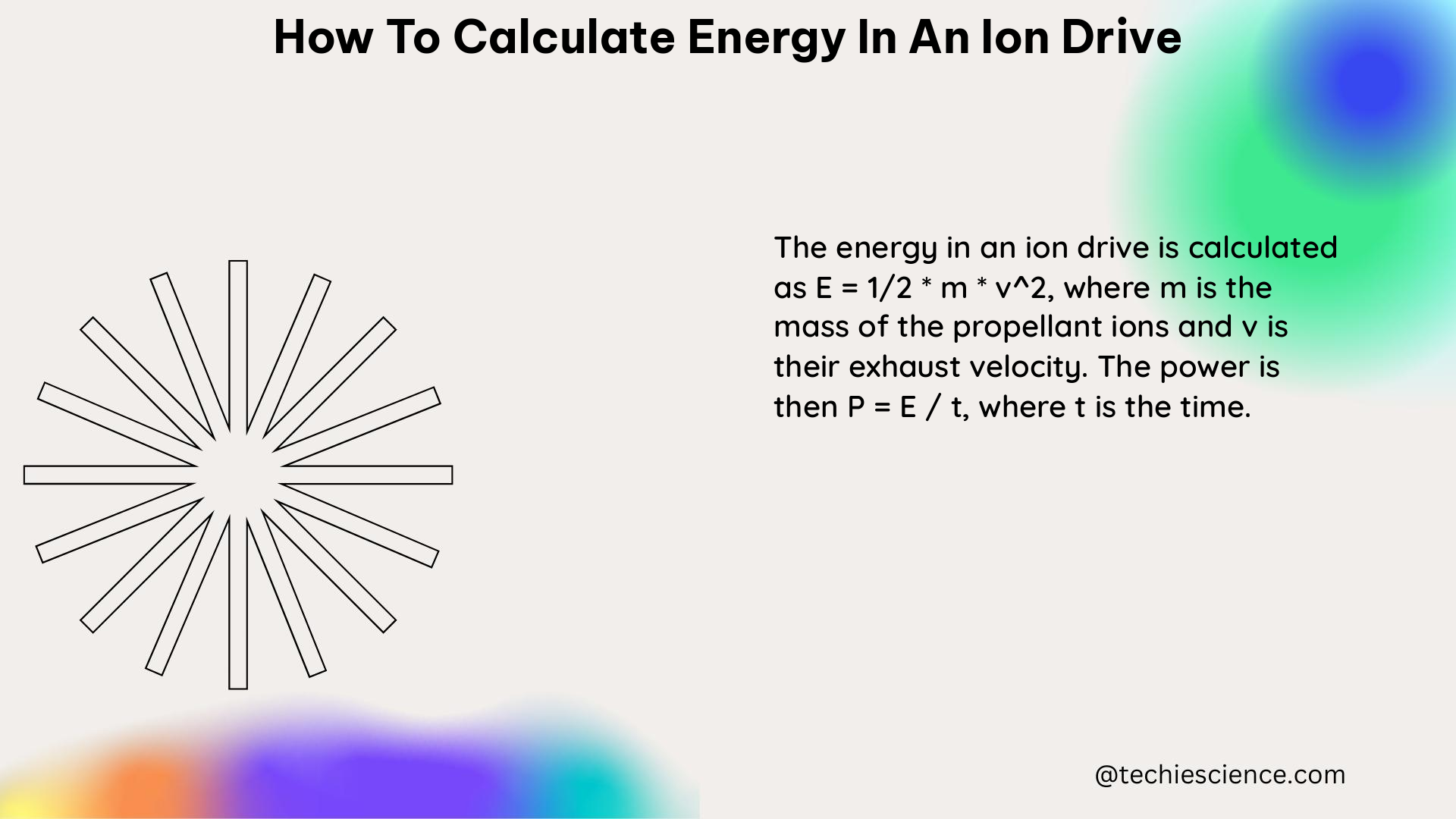Calculating the energy output of an ion drive is a crucial step in understanding the performance and efficiency of this type of electric propulsion system. This comprehensive guide will walk you through the step-by-step process of calculating the energy in an ion drive, covering the essential factors, formulas, and experimental techniques involved.
Understanding the Fundamentals of Ion Drives
Ion drives, also known as ion thrusters, are a type of electric propulsion system that uses electrostatic or electromagnetic fields to accelerate ionized propellant to high velocities, generating thrust. The energy output of an ion drive is directly related to the kinetic energy of the accelerated ions.
The key factors that determine the energy output of an ion drive are:
- Ion Mass: The mass of the ions being accelerated, typically measured in atomic mass units (amu) or kilograms (kg).
- Ion Velocity: The velocity of the accelerated ions, typically measured in meters per second (m/s).
- Ion Production Rate: The number of ions produced per unit of time, typically measured in ions per second (ions/s).
Calculating the Kinetic Energy of Ions

The kinetic energy (KE) of an individual ion can be calculated using the formula:
$$KE = \frac{1}{2} mv^2$$
Where:
– $m$ is the mass of the ion in kilograms (kg)
– $v$ is the velocity of the ion in meters per second (m/s)
For example, let’s consider a hypothetical ion drive that produces xenon ions with a mass of 218 amu (atomic mass units) and a velocity of 10^5 m/s. The kinetic energy of each ion would be:
$$KE = \frac{1}{2} mv^2 = \frac{1}{2} (218 \times 1.66 \times 10^{-27} kg) (10^5 m/s)^2 = 2.24 \times 10^{-14} J$$
Measuring Ion Mass and Velocity
To accurately calculate the kinetic energy of the ions, you need to measure their mass and velocity. Here are the common experimental techniques used for these measurements:
Measuring Ion Mass
- Mass Spectrometry: A mass spectrometer is used to separate ions based on their mass-to-charge ratio, allowing for the determination of the ion’s mass.
Measuring Ion Velocity
- Velocity Selector: A velocity selector uses a combination of electric and magnetic fields to select ions with a specific velocity, enabling the measurement of the ion’s velocity.
Calculating the Total Energy Output
Once you have the kinetic energy of a single ion and the ion production rate, you can calculate the total energy output of the ion drive by multiplying the kinetic energy per ion by the number of ions produced per second:
$$E = KE \times \text{Ion Production Rate}$$
Continuing the example from earlier, if the ion drive produces 10^15 ions per second, the total energy output would be:
$$E = KE \times \text{Ion Production Rate} = 2.24 \times 10^{-14} J/ion \times 10^{15} ions/s = 224 W$$
Therefore, the ion drive would have a power output of 224 watts.
Factors Affecting Energy Output
It’s important to note that the energy output of an ion drive can be affected by various factors, including:
- Propellant Type: The type of propellant used, such as xenon, argon, or krypton, can impact the mass and ionization characteristics of the ions.
- Thruster Voltage: The voltage applied to the thruster can influence the acceleration and velocity of the ions.
- Ionization Efficiency: The efficiency of the ionization process, which converts the neutral propellant into charged ions, can affect the overall energy output.
To ensure accurate calculations of the energy output, it’s crucial to carefully measure and control these factors during the experimental setup and data collection process.
Practical Applications and Considerations
Ion drives are widely used in spacecraft propulsion systems, particularly for long-duration missions where high specific impulse and efficiency are crucial. Understanding the energy output of an ion drive is essential for:
- Mission Planning: Calculating the energy output helps determine the thrust, specific impulse, and overall performance of the ion drive, which are critical for mission design and trajectory optimization.
- Power System Design: The energy output of the ion drive is a key factor in sizing the spacecraft’s power generation and distribution systems, ensuring a reliable and efficient power supply.
- Optimization and Efficiency Improvements: By analyzing the energy output and its relationship with various factors, researchers and engineers can work to optimize the design and operation of ion drives, improving their overall efficiency and performance.
Conclusion
Calculating the energy in an ion drive is a fundamental step in understanding the performance and capabilities of this type of electric propulsion system. By following the steps outlined in this comprehensive guide, you can accurately determine the energy output of an ion drive, taking into account the mass and velocity of the ions, as well as the ion production rate. This knowledge is crucial for mission planning, power system design, and ongoing optimization efforts in the field of ion drive technology.
References
- “Thrust measurement of an ion thruster by a force probe approach” – Link
- “Fundamentals of Electric Propulsion: Ion and Hall Thrusters” – Link
- “Relativistic Energy | Physics – Lumen Learning” – Link

The lambdageeks.com Core SME Team is a group of experienced subject matter experts from diverse scientific and technical fields including Physics, Chemistry, Technology,Electronics & Electrical Engineering, Automotive, Mechanical Engineering. Our team collaborates to create high-quality, well-researched articles on a wide range of science and technology topics for the lambdageeks.com website.
All Our Senior SME are having more than 7 Years of experience in the respective fields . They are either Working Industry Professionals or assocaited With different Universities. Refer Our Authors Page to get to know About our Core SMEs.